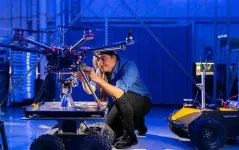(Press-News.org) High-grade glioma, an aggressive form of pediatric and adult brain cancer, is challenging to treat given the tumor location, incidence of recurrence and difficulty for drugs to cross the blood-brain barrier.
Researchers from the University of Michigan, Dana Farber Cancer Institute and the Medical University of Vienna established a collaborative team to uncover a potential new avenue to address this disease.
A study, published in Cancer Cell, shows that high-grade glioma tumor cells harboring DNA alterations in the gene PDGFRA responded to the drug avapritinib, which is already approved by the United States Food and Drug Administration to treat gastrointestinal stromal tumors with a PDGFRA exon 18 mutation as well advanced systemic mastocytosis and indolent systemic mastocytosis.
“We were excited to see that avapritinib essentially shut off PDGFRA signaling in mouse brain tumors,” said Carl Koschmann, M.D., ChadTough Defeat DIPG Research Professor and clinical scientific director of the Chad Carr Pediatric Brain Tumor Center at C.S. Mott Children’s Hospital.
Aside from surgery and radiation, there aren’t effective drugs to treat high-grade gliomas, especially upon recurrence. Koschmann and his collaborators targeted PDGFRA, which is one of the most commonly mutated genes, as a potential inroad to discover new drug therapies.
"We'd been doing screens with a lot of commercially available drugs that inhibit PDGFRA. We found avapritinib to be the strongest and most focused inhibitor that targets PDGFRA alterations,” Koschmann said.
Along with colleagues from the labs of Mariella Filbin MD, PhD (Dana Farber Cancer Institute) and Johannes Gojo (Medical University of Vienna) who were investigating the effectiveness of PDGFRA inhibitors, Koschmann and his team were excited to see that avapritinib crosses the blood brain barrier, a normally high hurdle for drugs.
"When we gave mice the drug and showed that it reached the brain, we knew we were onto something,” explained Kallen Schwark, a U-M M.D./Ph.D. student and one of the study’s lead authors.
The team was able to treat some patients with high-grade glioma through an expanded access program established by Blueprint, while a clinical trial was not yet available.
“Across multiple international institutions, we treated the first eight patients with high-grade glioma with avapritinib,” Koschmann explained.
“The patients tolerated the drug well and in three of the eight patients, we were able to see their tumors shrink.”
This early data and preclinical data helped provide the basis to include pediatric high-grade glioma in a phase I pediatric solid tumor trial, which recently completed accrual, and for which analysis is underway.
“We have very few examples of drugs entering brain tumors like this and shutting down key oncogenic pathways. These results support a lot of ongoing efforts to build on the success of avapritinib and other brain penetrant small molecule inhibitors,” Koschmann continued.
High-grade gliomas are very aggressive, with a prognosis of less than two years and limited treatment options. Though this work is preliminary, Koschmann is hopeful that avapritinib could be an additional tool to help patients.
“We know a single drug is not going to be enough for this disease,” he said.
“The way to make true progress will be combining many different types of modalities, like combining drugs that are target pathways activated by the first drug. We already have a follow-up story on targeting avapritinib with MAP kinase inhibitors that we are just as excited about.”
Additional authors: Mayr Lisa, Neyazi Sina, Schwark Kallen, Trissal Maria, Beck Alexander, Labelle Jenna, Eder Sebastian K, Weiler-Wichtl Liesa, Marques Joana G, de Biagi-Junior Carlos AO, Lo Cascio Costanza, Chapman Owen, Sridhar Sunita, Kenkre Rishaan, Dutta Aditi, Wang Shanqing, Wang Jessica, Hack Olivia, Nascimento Andrezza, Nguyen Cuong M, Castellani Sophia, Rozowsky Jacob S, Groves Andrew, Panditharatna Eshini, Alencastro Veiga Cruzeiro Gustavo, Haase Rebecca D, Tabatabai Kuscha, Madlener Sibylle, Wadden Jack, Adam Tiffany, Kong Seongbae, Miclea Madeline, Patel Tirth, Bruckner Katharina, Senfter Daniel, Lammerer Anna, Supko Jeffrey, Guntner Armin S, Palova Hana, Neradil Jakub, Stepien Natalia, Lotsch-Gojo Daniela, Berger Walter, Leiss Ulrike, Rosenmayr Verena, Dorfer Christian, Dieckmann Karin, Peyrl Andreas, Azizi Amedeo A, Baumgartner Alicia, Slaby Ondrej, Pokorna Petra, Clark Louise M, Cameron Amy, Nguyen Quang-De, Wakimoto Hiroaki, Dubois Frank, Greenwald Noah F, Bandopadhayay Pratiti, Beroukhim Rameen, Ligon Keith, Kramm Christof, Bronsema Annika, Bailey Simon, Guerreiro Stucklin Ana, Mueller Sabine, Skrypek Mary, Martinez Nina, Bowers Daniel C, Jones David TW, Jones Chris, Jager Natalie, Sterba Jaroslav, Mullauer Leonhard, Haberler Christine, Kumar-Sinha Chandan, Chinnaiyan Arul, Mody Rajen, Chavez Lukas, Furtner Julia, Koschmann Carl, Gojo Johannes and Filbin Mariella.
Funding/disclosures: This work was supported by Sajni Chakrabarti Fund for Pediatric Brain Cancer Research, Caroline Mortimer Fund, Claudia Adams Barr Program, Cuming Family Fund for Pediatric Brain Tumor Research, Anita, Sophia, and Athena Fund to Advance DIPG Research and Care, Liv Like A Unicorn, We love you Connie Fund and the DIPG All-In Initiative.
Filbin holds a NIH director’s New Innovator award (DP2NS127705), a Career Award for Medical Scientist from the Burroughs Wellcome Fund, the Distinguished Scientist Award from the Sontag Foundation, the Helen Gurley Brown Foundation Helen Gurley Brown Presidential Initiative at Dana-Farber Cancer Institute and the A-Award from the Alex’s Lemonade Stand Foundation. Filbin was also supported by National Cancer Institute SPORE grant 684 2P50CA165962 and by National Cancer Institute U54 grant CA274516. Koschmann was supported by National Institutes of Health Grant R01-NS119231 and R01-NS124607, DOD Grant CA201129P1, University of Michigan Chad Carr Pediatric Brain Tumor Center, Evans Family, ChadTough Defeat DIPG Foundation, Catching Up with Jack, Pediatric Brain Tumor Foundation, Michael Miller Memorial Foundation, Morgan Behen Golf Classic and Yuvaan Tiwari Foundation. Gojo was supported by Forschungsgesellschaft fuer cerebrale Tumore and Verein unser_kind. Jones was supported by Cancer Research UK, CRIS Cancer Foundation and Brain Tumour Research.
Other funding sources were Physician Researcher Pathway Scholarship of the Medical University of Vienna, the Medical-scientific fund of the Mayor of the federal capital Vienna (project #19086), the Austrian Science fund (project T906-B28 and P30105), Ministry of Health of the Czech Republic (NU20-03-00240) and Walter Benjamin Programme of the German Research Foundation.
Conflict(s) of interest: Filbin was a consultant for Redona Therapeutics (previously named Twentyeight-Seven, Inc.) and Blueprint Medicines Corporation.
Paper cited: “Effective targeting of PDGFRA-altered high-grade 1 glioma with avapritinib,” Cancer Cell. DOI: 10.1016/j.ccell.2025.02.018
END
Re-purposed FDA-approved drug could help treat high-grade glioma
Avapritinib, an FDA-approved drug used to treat other types of cancer, also decreases aggressive gliomas in animal models and in an initial cohort of patients with high-grade glioma
2025-03-13
ELSE PRESS RELEASES FROM THIS DATE:
Understanding gamma rays in our universe through StarBurst
2025-03-13
WASHINGTON, D.C. — The U.S. Naval Research Laboratory (NRL), in partnership with NASA’s Marshall Space Flight Center (MSFC), has developed StarBurst, a small satellite (SmallSat) instrument for NASA's StarBurst Multimessenger Pioneer mission, which will detect the emission of short gamma-ray bursts (GRBs), a key electromagnetic (EM) signature that will contribute to the understanding of neutron star (NS) mergers.
NRL transferred the instrument to NASA on March 4 for the next phase, environmental ...
Study highlights noninvasive hearing aid
2025-03-13
WINSTON-SALEM, N.C. – March 13, 2025 – A study from researchers at Wake Forest University School of Medicine highlights a new approach in addressing conductive hearing loss. A team of scientists, led by Mohammad J. Moghimi, Ph.D., assistant professor of biomedical engineering, designed a new type of hearing aid that not only improves hearing but also offers a safe, non-invasive alternative to implantable devices and corrective surgeries.
The study recently published in Communications Engineering, a Nature Portfolio journal.
Conductive ...
NASA taps UTA to shape future of autonomous aviation
2025-03-13
Envision a world where unmanned aircraft deliver goods to your front door and transport passengers in flying taxis, cargo planes cross continents carrying vital trade goods, and fighter jets patrol battle zones—all without a human pilot at the controls.
Those scenarios might seem a bit far-fetched now, but researchers are working diligently to develop these aircraft and ensure they operate safely. That’s why NASA has awarded a $1 million grant through its University Leadership Initiative (ULI) to a team from The University of Texas at Arlington Research ...
Mutations disrupt touch-based learning, study finds
2025-03-13
You may scarcely notice it, but much of what you do every day requires your brain to engage in perceptual learning. To safely cross an intersection or quickly retrieve something from your bag, you depend upon your brain to first assign meaning to sensory input from your eyes or fingertips.
Usually, it’s effortless.
Research from The Herbert Wertheim UF Scripps Institute for Biomedical Innovation & Technology shows a gene called Syngap1 enables touch-based perception, while certain mutations can lead to mixed signals. The research was made possible through grants from the National Institute of Mental Health and the National Institute ...
Misha lived in zoos, but the elephant’s tooth enamel helps reconstruct wildlife migrations
2025-03-13
Teeth recovered from a beloved zoo elephant that died in 2008 are helping University of Utah geologists develop a method for tracking the movements of large herbivores across landscapes, even for animals now extinct, such as mastodons and mammoths.
Outlined in recently published findings, the technique analyzes isotope ratios of the element strontium (Sr), which accumulates in tooth enamel. For large plant-eating land mammals, the relative abundance of two strontium isotopes in teeth and tusks ...
Eat better, breathe easier? Research points to link between diet, lung cancer
2025-03-13
For cancers of organs like the liver, the long-term impact of our diet has been well studied — so much so that we have guidance about red meat, wine and other delicacies.
A new study from researchers at University of Florida Health looks at another kind of organ whose cancer risk may be affected by poor diet: the lungs. The study was funded by several National Institutes of Health grants and a collaboration between the University of Kentucky's Markey Cancer Center and the UF Health Cancer Center.
“Lung ...
Mesozoic mammals had uniform dark fur
2025-03-13
The early mammals that lived alongside the dinosaurs upwards of 150 million years ago (mya) were likely covered in dark and dusky greyish-brown fur, according to a quantitative reconstruction of Mesozoic mammal coloration, hinting at their shrouded and nocturnal nature. The findings, drawn from a comparative analysis of fossilized melanosomes, provide insights into the ecology and evolutionary history of early mammals. From communication to camouflage, animal coloration plays an important role in numerous behavioral ecological ...
Wartime destruction of Kakhovka Dam in Ukraine has long-term environmental consequences
2025-03-13
The deliberate destruction of the Kakhovka Dam in Ukraine during the Russo-Ukrainian war unleashed a hidden environmental crisis, destroying ecosystems and releasing polluted sediments into downstream water systems, according to a new study. The findings provide critical new insights into the prolonged ecological risks of strategic dam destruction during warfare and the effects that may persist for years beyond war. “Our work highlights the far-reaching environmental consequences of the [Kakhovka Dam] destruction and raises concerns not only about the use of water as a weapon, but also about ...
NIH’s flat 15% funding policy is misguided and damaging
2025-03-13
The U.S. National Institutes of Health’s recent decision to impose a 15% cap on facilities and administrative (F&A) cost reimbursements threatens to undermine the quality and sustainability of university research by slashing indirect funding by $4 billion. In a Policy Forum, Jeongwon Choi and colleagues argue that this policy is fundamentally flawed, as it disregards the essential role of indirect costs, such as infrastructure, utilities, and administrative support, in enabling scientific research. The current system, governed by rigorous federal oversight and audits, ensures that F&A reimbursements are fair and necessary, varying across institutions based on actual costs. NIH’s ...
AI reveals new insights into the flow of Antarctic ice
2025-03-13
As the planet warms, Antarctica’s ice sheet is melting and contributing to sea-level rise around the globe. Antarctica holds enough frozen water to raise global sea levels by 190 feet, so precisely predicting how it will move and melt now and in the future is vital for protecting coastal areas. But most climate models struggle to accurately simulate the movement of Antarctic ice due to sparse data and the complexity of interactions between the ocean, atmosphere, and frozen surface.
In a paper published March 13 in Science, researchers at Stanford University used machine learning to analyze high-resolution ...
LAST 30 PRESS RELEASES:
Strategic river sensors could have forewarned of Texas Camp flood disaster
Drone sampling of whale breath reveals first evidence of potentially deadly virus in Arctic
Roman soldiers defending Hadrian’s Wall infected by parasites, study finds
Pinochet’s prisoners were tormented with music but still found solace in it, a new book reveals
Fertility remains high in rural Tanzania despite access to family planning
AI-assisted device can improve autism care access
Kinetic careers
Uncovering how parasitic plants avoid attacking themselves to improve crop resistance
Nanoparticle vaccine strategy could protect against Ebola and other deadly filoviruses
Study finds brain care score can predict risk of stroke across racial groups
Key lung immune cells can intensify allergic reactions
Do hormones explain why women experience more gut pain?
New materials conduct ions in solids as easily as in liquids
Breakthrough of the Year: Renewable energy begins to eclipse fossil fuel-based sources
LLM use is reshaping scientific enterprise by increasing output, reducing quality and more
Introducing LightGen, a chip for ultra-fast, ultra-efficient generative AI
Astronomers see fireworks from violent collisions around nearby star
ACC/AHA issue new guideline on managing congenital heart disease in adults
Cosmic crash caught on camera
Is talented youth nurtured the wrong way? New study shows: top performers develop differently than assumed
Ants: An untapped resource in the development of antibiotics?
Archaeologists use AI to create prehistoric video game
Mitochondria migrate toward the cell membrane in response to high glucose levels
Tiny viral switch offers hope against drug-resistant bacteria
Most parents aware of early peanut introduction guidelines, but confused about details
HPV vaccine can protect against severe lesions of the vulva and vagina
Virtual care provision and emergency department use among children and youth
Quadrivalent HPV vaccine and high-grade vulvovaginal lesions
Insights into dry eyes gained from stem cell-derived tear glands
Researchers identify 166 human pluripotent stem cell lines available for use in clinical applications
[Press-News.org] Re-purposed FDA-approved drug could help treat high-grade gliomaAvapritinib, an FDA-approved drug used to treat other types of cancer, also decreases aggressive gliomas in animal models and in an initial cohort of patients with high-grade glioma



